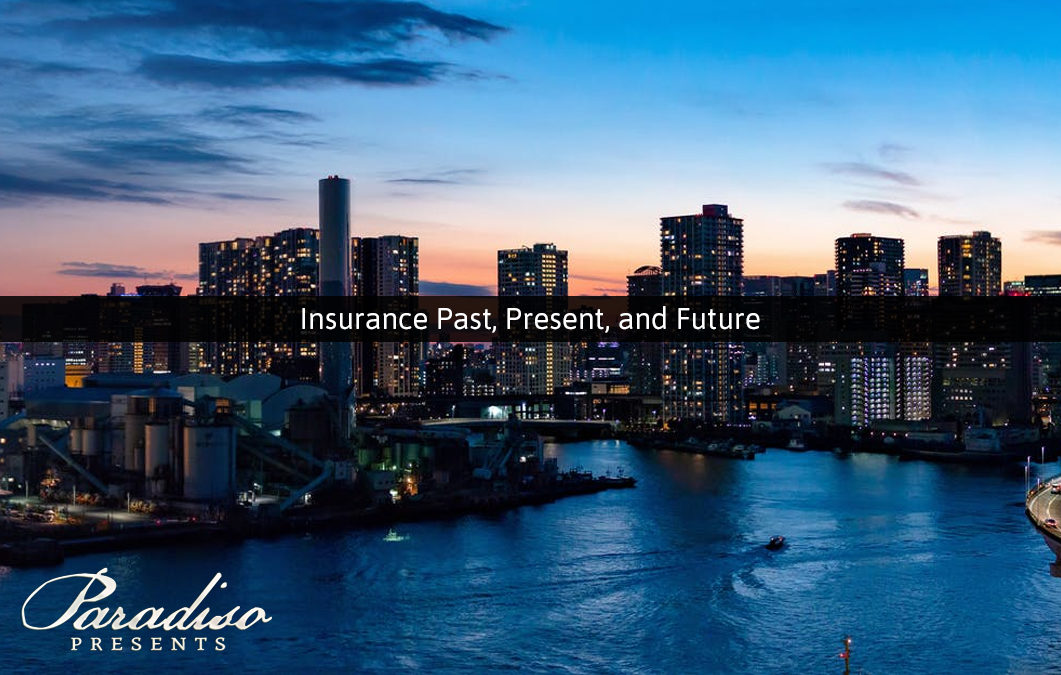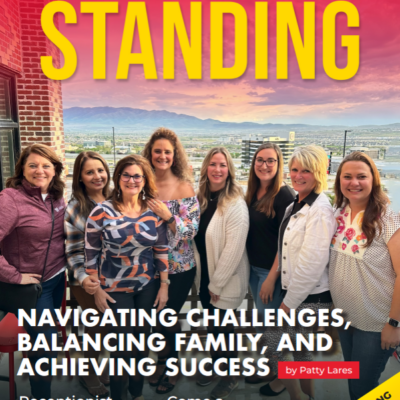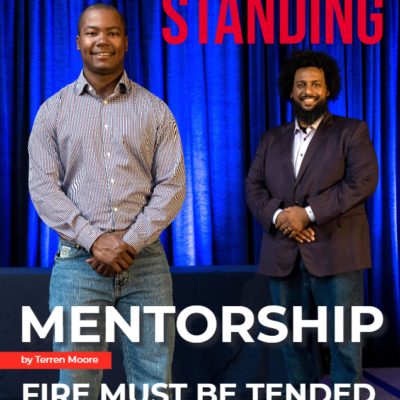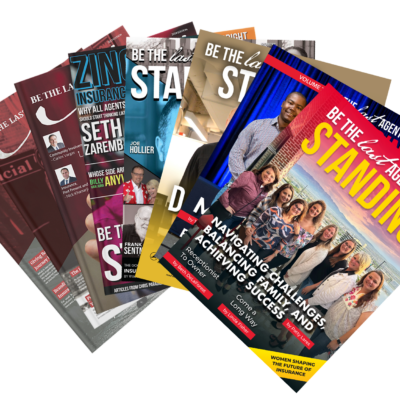Embracing InsurTech is Wise
Part III – Insurance Future
“Why the hell would I want to get my insurance license?”
That was my first reaction when my dad suggested I get my producer licenses. While my family was filled with lawyers and landlords, no one was in the insurance industry. I like to say that I ‘fell’ into insurance. I guess it was inevitable as my love for numbers and problem-solving instantly went to work building an independent insurance agency from scratch.
But, I also love technology, having bought my first IBM computer when I was 8. I’ve been both an independent insurance agency owner and an InsurTech founder and I know the struggles agencies face. I see the impact that technology can have on agencies should they embrace solutions coming out of this corner of the industry.
You’d be foolish to undermine InsurTech. Others have missed this in the past. Think about how taxi companies have been upended by Uber. Remember travel agents before and after Priceline? Even now, hoteliers are adjusting to AirBnb’s new competition. Now is the time to embrace.
ronoco – How Technology Improves Insurance Experiences
At ronoco, we create innovative and efficient applications that enable people to experience insurance in a new way. Users can maintain their assets, link their policies, and get meaningful advice. For individuals or companies with many assets and policies, dealing with insurance is an incredibly complex experience even with the best agents on your team.
When you have dozens of assets to protect, you’re often dealing with a handful of agents to get the coverages you need. We wanted to start by making that experience better for people. We do this by allowing users to see everything in one place. Agents that adopt this model can win over more business from their existing clients and separate themselves from their competition. For users, this means no more shuffling through file cabinets or online storage, or calling insurance companies for the most essential information about your coverage. For agents, the experience we provide has been described as a game-changer. We’ve also teamed up with FICO to provide meaningful AI-driven advice based on each user’s unique situation.
My vision is to unshackle insurance agents from the office and agency management system enabling them to conduct business on-the-go by using a versatile digital insurance platform.
I believe this helps fix a number of problems our industry is facing today. As the InsurTech movement evolves, ronoco will be at the forefront of building the the independent insurance experience of the future by bringing agents and clients closer together.
Status Quo
What really makes you different from your independent agency competitors? Everyone touts amazing service and the best carriers – but is there anything that clearly makes you stand out?
Over five years as an agency owner, I realized that the operating standards were not what I needed to deliver clients the amazing experience I’ve envisioned. It was difficult to meld together the available technology that I needed to be able to grow my business because of the manual processes that are standard to our front and back office. The purpose of bringing these efficiencies to the process is to leverage technology that will enhance the agent-client human-to-human relationship with is irreplaceable.
If you’ve ever hitched an Uber before, the experience is very different than a taxi. I always get into a conversation with my driver about how long they’ve driven with Uber, what they like or don’t like about it, and then onto topics of the day. I’ve never done that in a taxi. Why? Uber takes all the guesswork out of the experience for both driver and passenger by automating the transactional elements through a mobile application.
Rebuild & Restart
When I decided to rebuild and restart, I had already realized that the next wave of competitive advantages in this industry will be the use and application of technology. The industry is starting to realize there are a handful of significant hurdles and an outdated experience wasn’t the only one.
The first, many people in the insurance workforce will retire in this next decade. Secondly, millennials were disinterested or unaware of a career in insurance, however vast the opportunities. Finally, there was hints of a coming wave of innovation and disruption to every corner of this five trillion dollar industry. To put this number in perspective, if you stacked five trillion one dollar bills from Earth to the Moon, they would reach the moon and you would still have plenty to spare.
The insurance industry is one of slow response and change. If insureds don’t demand more from their agents, carriers, and policies, there’s no real need to enhance. Status quo works well for an industry built on risk-aversion because anything else is too risky to be certain enough to gamble on. So, while insurance companies are slow-moving and hesitant to take risks, the wave of InsurTech spearheads the research and development of innovative and disruptive ideas. Most will fail. Perhaps because they are outsiders with experience in technology and software development but lack a comprehensive understanding of the ins-and-outs of how this vast and complex industry functions.
If you haven’t yet, I’d urge you to see what’s going on with InsurTech. There’s a lot of new and creative businesses sprouting up that are itching for industry professionals’ expertise and a lot for the industry to consider when looking to grow and improve. Many of us are the millennials our industry has been looking for and needs to keep moving forward.
While I began with Part III because I believe it’s the most important, I hope you’ll continue to read Parts I & II.
Part I – Insurance Past
In order to gain a comprehensive understanding of how something will develop in the future, it’s wise to retrace the steps back to the origin, track its evolution, and determine the what, why, and how it progressed. From this vantage point, we can try to intelligently predict future trajectories rather than making under-informed gambles.
Antiquity
Taking shape in different forms, we know quite a bit about the aversion of risk dating back to at least 3,000 BC when Chinese merchants would pool collectively to protect commercial shipments of goods. During the 2nd millennium BC, Babylonians, Phoenicians, and other Mediterranean societies had developed the same into written legal instruments such as Hammurabi’s Code and the Rhodian Sea Law.
Modernity
As we understand it today, modern insurance got its start in London. Nicholas Barbon, an economic theorist whose works influenced many future political, economic, and social thinkers, spearheaded the first successful fire insurance company called the “Insurance Office for Houses” in 1681. A few years later, around 1688, Edward Lloyd’s infamous coffee house was where investors and merchants would gather and pool funds to protect ships and their cargo. These businessmen would indicate the value of the risk they were assuming on paper and write their name and the percentage they were insuring for under the description of what was being protected – hence the term ‘underwriting.’
Soon after in 1693, Sir Edmund Halley gathered some of the first mortality and life expectancy tables in Europe. In 1752, Benjamin Franklin established insurance for well-constructed and maintained homes in and around Philadelphia.
Fast forward a few centuries to after the Great Depression where citizens demanded progressive social reforms which produced a boon for an industry that matured into a stable, profitable, and high-employment industry with products that transformed from a luxury for the few to a necessity for the masses. From the late 1930s through the dot-com era especially, the profession of insurance agents and brokers as trusted advocates developed into white-collar professions.
Having spent 5 years as a young insurance agency owner, I’ve listened intently to dozens of stories from some of my oldest clients of their insurance agents during these golden years. Their stories are of agents as a community-person whom they knew from their local place of worship, their child’s school, or other community associations. Agents would frequently walk down the street on a monthly basis collecting premiums – some as small as $0.25. Often, the agent would come and spend time with their family, enjoy a cup of coffee in their living room talking about current events, local news, and business.
They were, and still are, in the business of protecting their clients and providing peace of mind both for the uncertainties that any ‘tomorrow’ would bring and the potentially life-altering uncertainty should a tragedy occur should they not have a risk aversion plan. Agents listen to the concerns of their clients, take it back to the insurance corporations they represented, and provide solutions to ease the angst of their clients.
Rapid Progress
The most comprehensive and overlooked progress to the supply-chain occurred in the 1970s and 1980s with the establishment of organizations such as the Insurance Services Office (ISO), the Association for Cooperative Operations Research and Development (ACORD), and consumer protection-focused government regulation. These factors began to quasi-commoditize the standard, personal insurance product to further establish the industry, policy, and coverages as we know them today.
While insurance is most certainly not a commodity in the real sense of the word, the standard, admitted, and well-rated carrier’s personal lines core product purchase is generally the same – if not similar enough. This is referred to as the commodity spectrum where insurance is slightly commoditized, and goods such as electricity, eggs, and paper have significant fungibility. With the former, even the relatively small amount of standardization that occurred paid off substantial societal dividends for insureds.
Prior to this standardization, attorneys, judges, and insurance adjusters would have to manually review the exact language of the specific policy from the company they were working with to figure out the coverages in place. The first thing many people learn about legal matters is that a single word can mean all the difference in a contract. Imagine when every company had even slightly different wording in their policy contracts that would need to be reviewed during each claim and lawsuit! Before this standardization, many insureds would have to purchase multiple policies to cover different perils just to protect their home.
While your home insurance policy is not nearly as fungible as a dozen eggs, the maturation in the late 20th century of the industry brought about enough fundamental standards to place that policy on the lower end of the commodity spectrum. This relatively minor progress gave consumers, businesses, and courts trust in the standard provisions of these contracts.
Today, we can trust that most of the base policy language is uniform. For example, a standard Homeowners’ Policy (ISO HO-3) covers the same things from carrier A to carrier B if it is written on a current ISO policy form. The frills of the policy may be different just as your eggs and milk may or may not be organic, natural, grass-fed, or cage-free. To many, the difference between a dozen eggs is the price. To others, the difference is the quality.
Part II – Insurance Present
The assets of commerce were protected well before societies provided insurance to protect the individual. Pat Ryan, the founder of AON, said it best when he said, “commerce does not exist without the insurance industry.” Adam Smith, the father of modern economics, postured that “the trade of insurance gives great security to the fortunes of private people. By dividing among a great many that loss which would ruin an individual, it falls light and easy upon the whole society.”
Theory and Reality
The industry of protection and risk aversion took many years to progress from commercial uses into a personal luxury and quickly grew to a necessity for the masses. Why has it snowballed to be a necessity? Insurance is a great enabler. It allows us to trust in a system where we all contribute according to our potential risk for the benefit of peace of mind. It also enables us to do business with complete strangers because we are assured of the ability to be made whole. Furthermore, it provides for more experimentation and innovation as people and companies are willing to take reasonable risks they may not have previously because of the assurance of protection for ourselves or from another should they be liable for our loss that it provides.
Nobel-laureate for his work in game theory, John Forbes Nash, Jr.’s work shows that the optimal situation is when every person in a group makes the best decision for himself individually while simultaneously considering what is also best for the group. Referred to as Nash’s Equilibrium, this is currently extremely difficult to achieve for insureds as our system is more disjointed than cooperative. While we all contribute through our premiums according to our calculable risk, our claims are handled individually. The potential benefit is great as there is only an advantage to increase or inflate a claim.
Because of this, every member of the group attempts to do as well as they can individually which leads to inefficiencies. There are a number of organizations, including the FBI, and entire departments in companies that deal specifically with insurance fraud. While it’s difficult to ascertain the actual amounts, figures conservatively estimate over $80 billion in fraudulent claims per year with approximately half of this – $40 billion – stemming from health-related claims.
An understanding of game theory can help comprehend this. Fraud is rampant because individuals in a group who cannot attain Nash’s Equilibrium will do what’s best for themselves individually when they can’t cooperate. Nash argues that when people rationally follow their self-interest, the best outcome is hard to reach causing these inefficiencies. While it would be best for the group – which is every insured – to be honest, everyone’s monetary self-interest in the increased payouts benefits more than the concern for the group. This inefficiency in our system costs the average American family between $400 and $700 per year of increased premiums.
Compounding Inefficiencies
Today, insurance companies deal with both price and non-price competition. In its simplest form, price competition comes from the premium of the core product. For example, the standard Homeowner’s Policy (ISO – HO3) with equal endorsements from two well-rated carriers will ultimately compete based on price. When an insured compares apples-to-apples, they’re comparing two quite fungible products.
However, when the policies vary based on certain specific features or endorsements, it’s non-price competition which companies use to separate themselves from their competitors. An example of this is when a carrier builds a policy with an endorsement to guarantee the claim payout of a home no matter the cost even if the damage exceeds the limits on your policy. This differentiates its product from another carrier’s which limits the claim to the replacement cost coverage amount allotted on the declaration page – and not a penny more.
Furthermore, many insurers compete in the non-price competition. GEICO typically spends more than $1B each year in marketing and advertising because its product is similar enough, but not identical, to any other insurer. Many carriers need to do this to stand out because price is no longer a substantial factor as their products are even further along the spectrum of commoditization than others. Evidence of this is plain and simple – we all see it everywhere. What’s more, pay-per-click advertising for insurance keywords also outrank all other industries and contributes over 25% of Google’s advertising revenue which is expected to exceed $73B in 2017.
Stagnation and Opportunity
While most of us don’t see or realize it, the standardization discussed in Part I which took place in the 1970s and 80s hasn’t changed much since then. Sure, insurance professionals don’t typically use tables and manual calculations anymore (although, you’d be surprised to find out that some still do!). The advent of the computer and the ability to process insurance transactions online did bring great strides to the industry, but it has been otherwise stuck. Much of this is due to the age of many in the industry as the average agency owner is 61 years old. Today, every cog along the insurance supply is desperate for the innovative and creative minds of millennials.
This can be interpreted as a good thing! We certainly don’t want rampant change to the industry of keeping our minds at ease unless it’s well thought out and strategically planned. Also, there’s plenty of opportunity.
A Millennial’s Experience
The experiences I’ve had in this industry, I doubt I would have ever had the opportunity for in any other. Currently, I serve as President of the Connecticut Young Insurance Professionals which is run and lead by bright, young industry leaders. I’ve also had multiple opportunities to meet and discuss insurance legislation and issues in Hartford, CT and Washington, D.C. with state and federal politicians and legislators. What’s more, I’m surrounded by my elders who are brilliant individuals committed to the improvement of insurance in various ways – many of whom have made their own significant contributions. I consider them mentors, glean from their achievements, and admire their successes.
This is insurance today. At its foundation, insurance will always be focused on protecting and providing for the greater good. This is why insurance exists. But for a financial mechanism that reaches back over 5,000 years, a major wave of innovation and improvement will rapidly reshape the how of this great industry as it’s poised with significant opportunities for impact and mailable growth. Sure, there are inefficiencies all around…but that’s what makes it so exciting.





